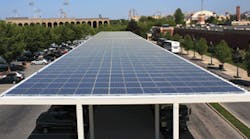If what gets measured gets done, then what's said publicly becomes reality. "Two years ago we set our goals and spelled out exactly what we were doing," explains Diane Alwine, director of environmental affairs at Hershey Co. "We don't set goals to fail. We want to meet and hopefully exceed our expectations."
In the company's first corporate sustainability report in 2009, the specific goals were to:
- Reduce emissions 15% from primary sources or energy conservation by 2011
- Reduce water use 15% by 2011
- Reduce waste generation 15% by 2011
- Complete waste audits of all wholly owned Hershey plants by 2010
- Increase waste recycling in wholly owned manufacturing plants to 80% by 2012
- Bring at least one manufacturing plant to zero waste-to-landfill (ZWL) status by 2012.
Alwine is happy to report in 2012 the company exceeded its goal of zero waste-to landfill status, and rather than having one ZWL plant, it has three. As for the other goals, all but the water reduction goal has been met.
Exceeding this waste goal was achieved through a careful strategy that included a two-year analysis of the current state of Hershey's plants, which required the company to identify all significant waste streams.
During this process, it discovered that the Reese plant in Hershey, Pa., was particularly efficient at reducing waste as well as recycling.
In 2010 the Reese plant achieved ZWL status. Then the West Hershey, Pa., plant earned the same ranking in 2011. The Hazelton, Pa., plant, which completed a $225 million expansion in October 2011, became the company's third ZWL plant in February 2012.
Start with Leadership
Extensive cooperation at all levels of the company was required to achieve these landmarks. "Our employees understand the importance of sustainability and are working together to reach our reduction goals," says Terence O'Day, senior vice president of global operations.
It was O'Day's leadership that was the key to success, according to Alwine. "You have to have the endorsement of senior management to pull off a project of this nature. For those who are just beginning the process of reaching ZWL status, start with leadership and then move it through the rest of the company."
At the plant level, it's a joint effort between plant and corporate environmental departments as well as procurement. "It's the passion of the plant champion that keeps the ball moving," says Alwine.
Tradition of Environmental Stewardship
A passion for being environmentally conscious is part of the company's history. Hershey's recycling center, for example, can be traced back to 1936.
That tradition continues today as the company continuously improves both its recycling efforts and energy efficiency programs.
Diane Alwine
director of environmental
affairs, Hershey Co.
Other energy-saving measures include last year's installation of two solar arrays at facilities in Hershey, Pa. Generating an estimated 318 megawatt-hours (MWh) of electricity per year, these arrays will eliminate hundreds of metric tons of greenhouse gases annually.
In 2009, the company committed to reducing its greenhouse gas emissions 15 percent by the end of 2011 based on 2008 emission levels. The company said it is on track to achieve this goal by the end of the year.




